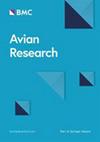Escape behaviors of the Eurasian Tree Sparrow (Passer montanus) across China: Northern populations are bolder than southern populations
IF 1.7
2区 生物学
Q1 ORNITHOLOGY
引用次数: 0
Abstract
Urbanization has significantly altered the habitat structure and behavioral patterns of animals. In urban environments with frequent human disturbances, animals may undergo adaptive adjustments in their escape behaviors. This study focuses on Eurasian Tree Sparrows (Passer montanus) from five cities across different latitudes in China, comparing their flight initiation distance (FID) in urban and rural areas to assess the impact of urbanization on their escape behavior and the trend of ecological homogenization. The results confirm the established pattern at the geographic level: a reduction of FID in urban habitats and a decrease in FID with increasing latitude. That is, northern populations of the Eurasian Tree Sparrow in China are bolder than the southern populations. In addition, FID is positively correlated with flock size, with rural flocks exhibiting more pronounced group behavior (observed flocking frequency for urban and rural is 28.74% vs. 40.7%, flock size variance is 26.90 vs. 55.63). Despite the differences between northern and southern latitudes, the variability of FID in urban individuals consistently remains lower than that in rural areas, supporting the trend of reduced variability in escape behavior among birds in urban environments. Driven by urbanization, the escape behavior of Eurasian Tree Sparrows tends toward ecological homogenization, meaning that behavioral differences between urban areas in different cities are diminishing. This trend may obscure the behavioral variability brought about by latitude gradients, indicating that urbanization not only shapes the behavioral adaptations of birds but also potentially weakens their behavioral diversity.
欧亚树雀(Passer montanus)在中国的逃跑行为:北方种群比南方种群更大胆
城市化极大地改变了动物的栖息地结构和行为模式。在人类干扰频繁的城市环境中,动物的逃跑行为可能会发生适应性调整。本文以中国5个不同纬度城市的欧亚树雀(Passer montanus)为研究对象,比较了它们在城市和农村地区的飞行起始距离(FID),以评估城市化对其逃离行为和生态同质化趋势的影响。结果证实了地理水平上的既定模式:城市生境的FID减少,随着纬度的增加FID减少。也就是说,在中国的欧亚树雀的北方种群比南方种群更大胆。此外,FID与羊群规模正相关,农村羊群表现出更明显的群体行为(观察到城市和农村的羊群聚集频率分别为28.74%和40.7%,羊群规模方差分别为26.90和55.63)。尽管南北纬度存在差异,但城市个体的FID变异性始终低于农村地区,这支持了城市环境中鸟类逃跑行为变异性降低的趋势。在城市化的驱动下,欧亚树雀的逃逸行为趋于生态同质化,即不同城市区域间的行为差异正在缩小。这一趋势可能掩盖了纬度梯度带来的行为变异性,表明城市化不仅塑造了鸟类的行为适应,而且潜在地削弱了它们的行为多样性。
本文章由计算机程序翻译,如有差异,请以英文原文为准。
求助全文
约1分钟内获得全文
求助全文
来源期刊

Avian Research
ORNITHOLOGY-
CiteScore
2.90
自引率
16.70%
发文量
456
审稿时长
46 days
期刊介绍:
Avian Research is an open access, peer-reviewed journal publishing high quality research and review articles on all aspects of ornithology from all over the world. It aims to report the latest and most significant progress in ornithology and to encourage exchange of ideas among international ornithologists. As an open access journal, Avian Research provides a unique opportunity to publish high quality contents that will be internationally accessible to any reader at no cost.
 求助内容:
求助内容: 应助结果提醒方式:
应助结果提醒方式:


